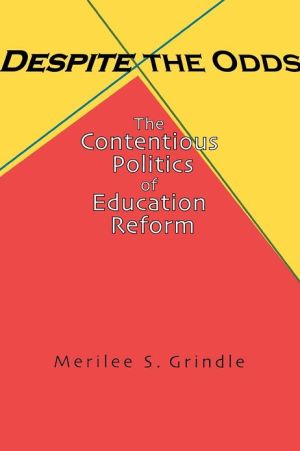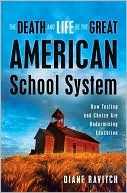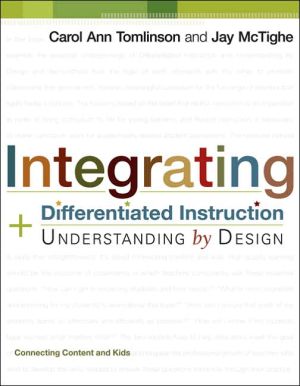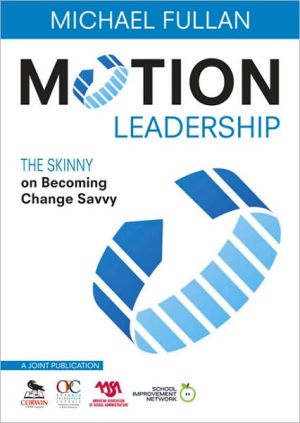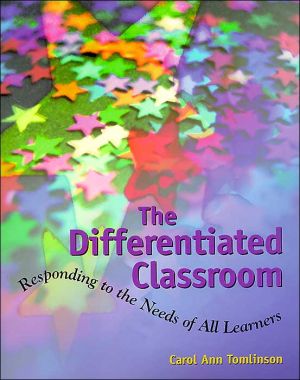Despite the Odds: The Contentious Politics of Education Reform
Despite the Odds poses an important question: How can we account for successful policy reform initiatives when the political cards are stacked against change? Theories of politics usually predict that reform initiatives will be unsuccessful when powerful groups are opposed to change and institutions are biased against it. This book, however, shows how the strategic choices of reform proponents alter the destinies of policy reforms by reshaping power equations and undermining institutional...
Search in google:
"A welcome and sorely needed addition to the literature on social sector reform. The book has important implications for developing countries as well as for the literature on political leadership, the role of international financial institutions, and even the dynamics of international policy diffusion."--Wendy Hunter, University of Texas"The book is valuable for political scientists and political economists interested in unpacking the policy process. Grindle's conceptual scheme applies beyond the education sector. It is helpful in addressing broader debates and generalizations about the politics of institutional reforms in general."--Joan M. Nelson, Senior Scholar, Woodrow Wilson Center, Smithsonian Institution; Scholar-in-Residence, School of International Service, American University
Despite the Odds\ The Contentious Politics of Education Reform \ \ By Merilee S. Grindle \ Princeton University Press\ Merilee S. Grindle\ All right reserved.\ ISBN: 0691118000 \ \ \ Chapter One\ A CONUNDRUM: REFORM DESPITE THE ODDS\ THIS BOOK POSES a conundrum for political analysis: How can we account for successful reform initiatives when the political cards are stacked against change? Education reform, which was high on political agendas throughout Latin America in the 1990s, is an intriguing case for posing this question. Definition of objectives and means, the interests of winners and losers, and shifting burdens of responsibility and accountability were among the many factors that brought reformers, politicians, teachers' unions, education administrators, governors, mayors, and others into conflict over the nature and scope of education policy during the decade. In these conflicts, the lineup of antireform forces was almost always imposing; support for change was, at best, lukewarm; and political institutions were usually unfriendly to initiatives that would alter the status quo.\ Despite these political odds, at least twelve countries in Latin America introduced important changes in national education policies during the 1990s.1 Defying predictions that they would shy away from contentious issues, politicians supported many of these changes, even in the face of mobilized opposition, acrimonious debates, and resistant bureaucracies. Although the reforms were not always as thoroughgoing as their proponents hoped, introduction and at least partial implementation of new education policies was a notable characteristic of the decade. How did this happen?\ The mobilization of interests and the distribution of institutional power are important factors in understanding the origin and nature of conflicts over policy. But neither interests nor institutions fully account for policy reforms that occur despite the political odds. In such cases, it matters a great deal how policy changes are introduced, approved, and implemented and how reformers manage this process as it unfolds over time. Often, the policy process introduces opportunities to alter the political equations and institutional biases that impede change. This is what made it possible for Latin America's reform proponents in the 1990s to create conditions under which new education policies could be introduced and sustained in political and bureaucratic environments rife with opposition. This book focuses on explaining these unexpected outcomes.\ Most analysts of education policy seek to assess efforts to improve conditions in the sector-increasing the efficiency with which services are delivered, reducing illiteracy and repetition rates, boosting student learning through new curricula and pedagogy, measuring the impact of standards-based testing, evaluating the results of school autonomy, and so forth. Research to assess the efficacy of various policy alternatives for improving education is a centrally important undertaking. But this kind of analysis usually takes the process of reform for granted-how improved education becomes part of a political agenda, how reform initiatives are developed, what interactions and negotiations shape or alter their contents, how important actors and interests respond to change proposals, how initiatives are implemented and sustained once they are introduced.\ These are the issues I seek to address; my objective is to understand the political dynamics that make alternative policy choices possible. Thus, when I refer to reform, I am not making a normative judgment about the appropriateness or goodness of specific change proposals, but simply signaling deliberate efforts to make changes in policies about education. The reforms undertaken may or may not improve the quality of services; I leave this determination to education specialists. My focus is instead on the politics surrounding initiatives for bringing about change.\ Centrally, I am interested in how reformers find room for maneuver in introducing new policies, particularly when new policies are politically contentious. But I am also interested in the limitations reformers face when they are not sufficiently sensitive to important sources of resistance or where the forces of opposition overwhelm change initiatives. Indeed, my findings indicate some ambiguity about the future of education reform where the support of teachers has been ignored, where hostile unions continue to oppose change, and where incentives for politicians, administrators, teachers, and parents work against new initiatives. In detailing some cases of relatively successful reform, I hope the following chapters represent a challenge to those who doubt the possibility of change; in detailing some failures, the book can also be a basis for considering how the politics of reform might be approached differently the next time around. At the most general level, it should provide insight into the tension between the interests and structures that inhibit change and the ability of reform agents to promote it.\ ADVOCATING FOR CHANGE\ Throughout Latin America in the 1990s, advocates of change argued persuasively that better education was critical if countries were to wage effective battles against endemic poverty and inequality, if they were to gain advantages from rapid globalization, and if they were to build and sustain democratic citizenship and institutions.2 They routinely urged politicians to commit more resources to education. Research centers, universities, and think tanks produced numerous studies of the problems of current systems and the imperatives for change. Similarly, international discussions during the 1990s emphasized the importance of education to political, social, and economic development.\ These advocates had good reason to stress the importance of attending to problems of public education. While most Latin American countries had achieved respectable literacy rates and widespread access to primary schooling by 1990, the region faced old and new education challenges. Increasing the supply of education was an ongoing problem. Some countries-Argentina, Bolivia, Chile, Panama, and Uruguay-had managed to achieve an average of eight years or more of schooling by the 1990s, but this average was five years or less in Brazil, El Salvador, and Nicaragua.3 Secondary school completion rates were below 20 percent in Honduras and Nicaragua, under 40 percent in Costa Rica, Paraguay, Brazil, Ecuador, El Salvador, Mexico, and Venezuela, and did not reach 60 percent in Argentina, Chile, and Peru.4 Because education is a critical factor explaining the persistence of inequality and poverty, the failure of the region to provide this service more effectively indicated a more general failure to address divisive social ills.\ A second problem was that of investment in education. In many countries, the social sectors had borne the brunt of austerity budgeting during the economic crises of the 1980s; by the early 1990s, mounting evidence of the deterioration of services and coverage could not be ignored. Regionally, between 1980 and 1985, public expenditures on education declined by 18 percent, and while some countries began to reverse the trend in the latter half of the 1980s, other countries did not.5 Expenditures declined as a portion of GNP between 1980 and 1991 in Costa Rica, the Dominican Republic, Ecuador, El Salvador, Mexico, Paraguay, and Uruguay.6 Teacher pay fell throughout the region and absenteeism increased as teachers, like many of their students, abandoned the classroom to find means to contribute to fragile household incomes. Textbooks and educational materials, school breakfasts, teacher training, and other critically important inputs suffered significant cutbacks.\ Thus, by the early 1990s, many ministries of education had made no substantial investments in expanded or improved facilities for a decade and were spending almost all of their budgets on salaries for personnel. In practice, this meant schools fallen into decay, no restocking of textbooks, no equipment replacement or repairs, and demoralized employees working two or even three jobs in order to make ends meet. In addition, a variety of perverse incentives for teachers and administrators undermined performance in the classroom and in organizations responsible for education services.7 Access to education was unequally distributed between urban and rural areas and, during the decade, many families with the resources to do so exchanged publicly provided services for private ones.\ But the concerns of most reformers went beyond issues of improved access to education and greater investment in the sector to a third problem. Increasingly, they were worried by evidence that the quality of education was low and, at times, abysmal. Many children attended school but learned little, an alarming number of them repeated grades, and dropping out of school with only a few years of education was the most frequent response to classroom failure and household economic need. Latin America's children did poorly on assessments of their accomplishments in mathematics and language, and scores systematically revealed differences between rural and urban schools and public and private ones. Increasingly, education experts asked if these children were going to have anything but dismal futures in an increasingly competitive global labor market.\ Advocacy for responding to such concerns was advanced when innovative ideas for new programs and policies were communicated more frequently and rapidly by the internet and when their circulation coincided with extensive international dialogues about human development. Comparisons of country achievements using a variety of social welfare indicators increased government sensitivity to their international reputations. To add further to the interest in change, international development agencies increased their loan portfolios in education and became important advocates of reform and of particular approaches to improved teaching, learning, efficiency, and effectiveness. More generally, rapid globalization encouraged new concerns about the probable destinies of countries with low skilled labor forces but with wage structures that made them internationally uncompetitive.8\ In addition, the political context in many Latin American countries was ripe for increased advocacy of reform. Democratic institutions were in place in almost all countries in the region by 1990, and the adoption of a variety of neoliberal economic reforms had increased citizen concern that governments were seeking market solutions to public problems regardless of their implications for equity, welfare, or national integration.9 The number of NGOs and community organizations interested in social conditions mushroomed during this period.10 Moreover, in some countries, powerful economic ministries were becoming more concerned about the efficiency of public sector investments and more aware of the importance of political and social conditions to international competitiveness. Considering only these factors, the situation seemed propitious for promoting education policy change. But new policies would also unleash contentious political realities.\ NEW POLICIES, NEW POLITICS\ By the 1990s, advocates for education policy change believed that reformed systems should increase the amount of learning in the classroom and that they should provide citizens with appropriate skills to lead productive lives in the twenty-first century. They argued that educational management had to become more efficient and should be the responsibility of those best able to oversee the day-to-day delivery of services. They were adamant that education be delivered by those with the knowledge and incentives to do it well.11 Within this broad consensus, many models for how to achieve these objectives vied for the attention of reform advocates.\ To turn the vision into reality, multiple reform proposals of the 1990s centered primarily on improving educational quality. Quality enhancement meant addressing the problem of poor management and inefficient use of resources by increasing accountability and reallocating responsibilities for performance. In the most ambitious reforms, states, municipalities, school directors, or local school boards were to be given responsibilities for hiring, promoting, disciplining, and firing teachers; national ministries were to be restructured, their jobs newly defined as setting national standards, monitoring outcomes, and financing rather than day-to-day tasks of classroom instruction. New initiatives would include efforts to reduce repetition and dropout rates by altering curricula and changing pedagogy. Multiculturalism and bilingual education were often part of such proposals. More attention to teacher training and monitoring often went hand in hand with proposals to tie salaries to performance and to greater accountability to supervisors or local communities. National standards were an important ingredient of reform ideas in several countries, and reform advocates supported regular examinations of student and teacher performance.\ These kinds of reform proposals introduced new political dynamics into the process of policy making and implementation. In earlier periods, many Latin American countries promoted policies to increase access to education and, during the 1950s, 1960s, and 1970s, schooling was expanded to many rural areas and to poor children in mushrooming urban squatter settlements. At the center of these access policies were efforts to increase education budgets, train and hire more teachers, build more schools, distribute more textbooks, and administer more programs.\ In general, these reforms were politically popular. Although they cost money and required some administrative capacity, access reforms provided citizens with increased benefits and politicians with tangible resources to distribute to their constituencies. They created more jobs for teachers, administrators, service personnel, construction workers, and textbook and school equipment manufacturers. They increased the size and power of teachers' unions and central bureaucracies. In fact, unions were often among the principal advocates for broader access to public education. Given these characteristics, it is not too much to argue that these reforms were "easy" from a political economy perspective.\ This could not be said of most of the 1990s initiatives in education. As indicated in table 1.1, quality-enhancing reforms generally involved the potential for lost jobs, and lost control over budgets, people, and decisions. They exposed students, teachers, and supervisors to new pressures and expectations. Teachers' unions charged that they destroyed long-existing rights and career tracks. Bureaucrats charged that they gave authority to those who "know nothing about education." Governors and mayors frequently did not want the new responsibilities they were to be given. Parents usually did not participate in designing the reforms, often did not understand them, and generally deferred to professionals in making judgments about educational quality.\ \ Continues...\ \ \ \ Excerpted from Despite the Odds by Merilee S. Grindle Excerpted by permission.\ All rights reserved. No part of this excerpt may be reproduced or reprinted without permission in writing from the publisher.\ Excerpts are provided by Dial-A-Book Inc. solely for the personal use of visitors to this web site. \ \
Ch. 1A condundrum : reform despite the odds1Ch. 2From public problems to political agendas27Ch. 3Sponsoring reform : executive leadership, formidable constraints58Ch. 4Designing reforms : problems, solutions, and politics93Ch. 5Contesting education : teachers' unions and the state119Ch. 6Contesting education : teachers' unions versus reformers140Ch. 7Implementing and sustaining change : new arenas for conflict165Ch. 8In process : the politics of education reform189
